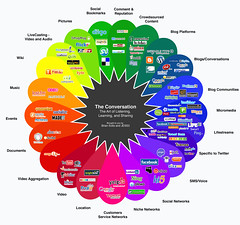Melanie McBride, a Toronto based writer-aggregator of education, technology, media and culture, wrote:
“Despite the popularity and widespread adoption of social tools, there’s little agreement when it comes to matters of our individual terms of use. Without a collective social contract for social media, many of us are left wondering: How do I define my own social policy? Until now, corporate social media developers are defining those policies for us. Some of us feel it’s time we defined social media according to our our own terms.
McBride posted a template, and encouraged her readers to “[Steal This] Personal Social Media Policy.” Since she has this licensed under Creative Commons, I’m sharing it with you here.
I challenge all users of social media, especially PR students, to adapt this template and create their own social media policies.
MY SOCIAL MEDIA POLICY
[a work in progress]
1. Connecting: Introduce yourself and tell me why you want to connect
[Would you like an introduction from new follows? Would you like them to answer a particular question about their interest in connecting? Define it here]
2. Follow, add, friend: [your subhead here]
[Your polices around friending, following and adding. For example, if people follow/friend you do you automatically reciprocate? Or do you prefer to evaluate the value of a contact over time? State it here, loud and clear]
3. Privacy, boundaries and safety: [your subhead here]
[Define your privacy/boundaries for friends, coworkers and family. Everybody has different ideas about what’s “too much information.” Friends, family and business associates have different ideas about who you are. While you may not be able to control what’s said about you, you can certainly ask your network to be mindful of your limits]
4. Signal to noise: [your subhead here]
[Do you have any strong feelings about the kind of social media experience you seek (or don’t)? For example, do you have a problem with people using RSS in their Twitter? Do you get annoyed by multiple status updates? Make that clear here (so people aren’t surprised when you unfollow them – or vice versa)]
5. Personal data and sharing: [your subhead here]
[What’s all this sharing about? (for you) Are you looking to connect more deeply according to shared interests, ideologies, professional goals?]
6. My networking needs and uses: [subhead here]
[How is your use of Facebook different from your use of Linkedin different from your use of Twitter different from your use of MySpace? What are your specific networking purposes or goals for each?]
7. Your criteria here: [subhead here]
[your policy, feelings, arguments here]
8. Your criteria here: [subhead here]
[your policy, feelings, arguments here]
Photo Credit: The Conversation Prism, originally uploaded to Flickr by b_d_solis









